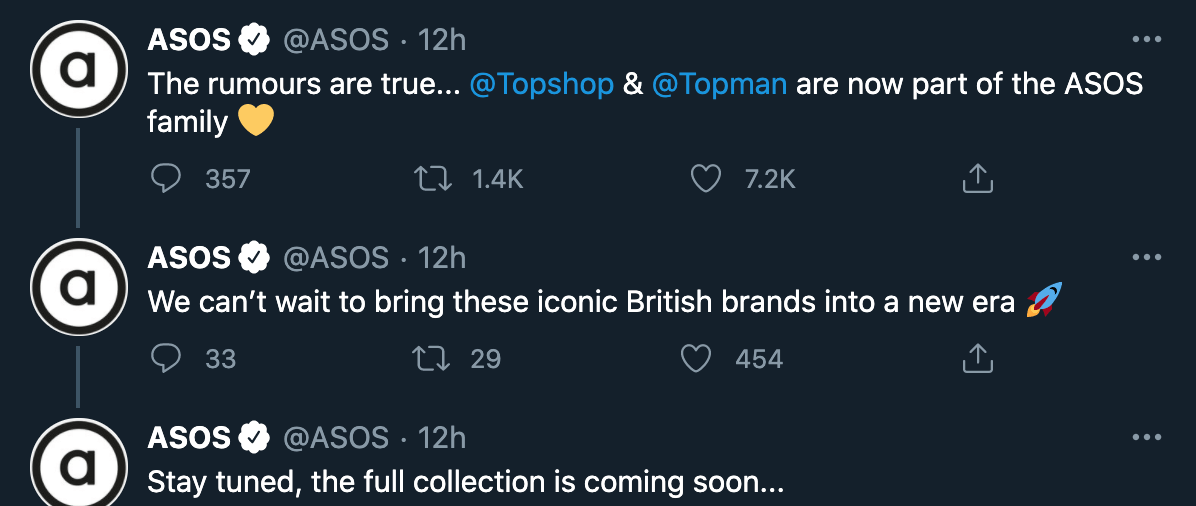Why Are ASOS and Boohoo Acquiring Traditional Brick-and-Mortar Brands?

We’ve heard the ongoing whispers that the high-street is on it’s way out for a while now and yes, although high-street shopping has been steadily declining it has still managed to retain a decent footfall and escape dying out completely.
However, Covid seems to be the final nail in the brick-and-mortar coffin. The footfall in high-street shops is at zero, with stores like Primark that don’t have an online presence reporting their sales plummeting by one hundred percent.
A few lucky shops that retail health products such as Boots or Holland and Barrett may still survive using the traditional model of high-street stores but with the pandemic accelerating our reliance on and preference of e-commerce, it seems high-street fashion brands will have to adapt faster than ever.
In the past couple of weeks online retailers have been busy taking advantage of this situation. ASOS have now acquired Arcadia group brands Topshop, Topman, Miss Selfridge and fitness band HIIT for $403.5 million, tweeting ‘We can’t wait to bring these iconic new fashion brands into a new era’.

Whilst Boohoo announced on the 25th of January that it had acquired “all of the IP of Debenhams” for $55 million and is in talks to buy Dorothy Perkins, Wallis and Burton, all of which also belong to Arcadia Group. Most relevantly none of these deals include the real estate of each respective brand.
ASOS’ acquisition of Topshop marks its first venture into mergers and acquisitions and puts them ahead in the global e-commerce market.
Their acquisition of the iconic British brand was no doubt prompted by Boohoo – one of their biggest competitors – acquiring the Debenhams website, an online marketplace that allows brands to list their inventory on the site themselves. This is a more convenient model that can be scaled fairly easily, compared to buying and storing the stock of individual brands as ASOS does.
This opens up new opportunities for Boohoo in areas such as homeware, beauty and sporting goods. This is important as the initial surge we saw in online shopping during the first lockdown was for clothing, shoes and accessories. This has now shifted to a focus on sprucing up our living spaces and maintaining our sanity and activity levels through home-workouts as we continue to weather the pandemic for the foreseeable future.
Unfortunately, many jobs will be lost as a result with Debenhams reporting 12,000 jobs at risk whilst Arcadia group cites 13,000 jobs will be lost.
So what is the benefit to brands like ASOS and Boohoo acquiring brands that appear to be on their way out? It seems the answer can be found in the fact that neither ASOS or Boohoo acquired any of the brick-and-mortar stores in their deals, not even Topshop’s famous flagship store in Oxford Circus (for now).
These acquisitions are more about the value of information, data and the established customer base, awareness and loyalty that these legacy brands have built over decades. I mean owning a pair of Topshop Jamie or Joni jeans is almost a rite of passage for teenage girls.
Brand loyalty is far less common online than when shopping on the highstreet was the supreme option. By acquiring these brands, ASOS and Boohoo acquire a transference of high-street heritage and culture, so it will be interesting to see how they manage to incorporate these acquisitions into their brands and revive them for the 21st Century and beyond.
Check out more fashion content here





![ZINO VINCI’S ‘FILTHY & DISGUSTING’EP BRINGS YOU TO THE CORE OF THE ARTIST [@ZinoVinci]](https://guap.co/wp-content/uploads/2023/10/Zino-4.jpg)



